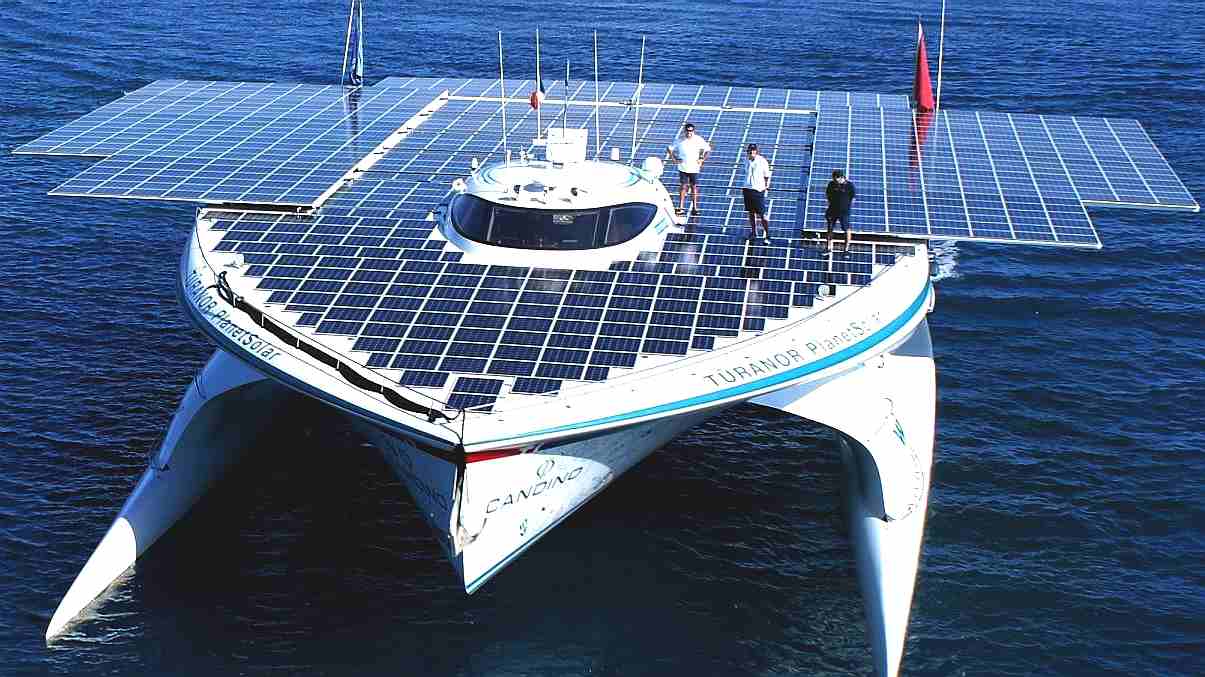
SCOUT
TRANSATLANTIC
- Was a brave attempt to cross the Atlantic using an unmanned
electrically propelled vessel, powered by solar panels. Well done chaps.
"Scout"
was a robotic boat designed to cross the Atlantic Ocean and reach Spain - a small boat on a big journey.
It was lost at sea and never recovered.
Scout, was a 13 foot long carbon fiber boat. It started its transatlantic journey to Sanlucar de Barrameda, Spain in the beginning of
June 2013. Designed and built by four friends, Scout had significant navigation capabilities as well as robust systems enabling it to travel on its journey completely autonomously.
The goal of this project was to send an autonomous boat across the Atlantic Ocean. If successful, it
would have beed the first such craft to do so. The closest publicized attempt was that of the Pinta- a sailboat which traveled 400 miles on its journey before it stopped transmitting its position.
Scoutís hull was a foam core covered with carbon
fiber. The electronics were all ready and working and the microcontrollers
programmed and ready for the voyage. The power system was completed with the addition of solar panels and batteries. Care
was taken in designing and programming these systems as they would have to endure the roughest of conditions for weeks on end without human intervention.
The electronic systems on Scout are straightforward (simple) but advanced. The onboard batteries
were capable of running all of Scoutís systems at full power for at least twenty five hours. Satellite tracking
was provided by a SPOT tracker and powered by enough lithium batteries to transmit for a number of months.
It was track-able on the team's website.
If the boat temporarily loses the GPS fix, it will trigger software that uses an onboard digital compass and data previously collected from the GPS to approximate its position. The keel has even been designed to shed
seaweed and other debris that would slow the boat. The forethought that has gone into these systems
was significant.
As is typical with such projects costs accumulated, despite volunteer
input, with the team needing to raise about two thousand and five hundred
$dollars, to cover the costs of what was a groundbreaking project, so as
to put more focus on the project itself, rather than funding
difficulties.
They were more than just a team of friends working towards a common goal
- they were able to make use of some fantastic resources available to
them, including world famous marine engineers and designers, offshore sailors and navigators, the Naval Undersea Warfare Center, and the resources of
their respective colleges.
Scout was a very exciting and ambitious project where four mates made significant progress on
a very tight budget, producing a vessel that was (in theory) fully capable of what
they set out to do.
THE
TEAM
Dylan Rodriguez has been an avid Scouter since 2010 and is stoked for the 2017 Scouting season. He's also been excited about discus launch gliders, electric skateboards, IOT doodads.
dylan@gotransat.com
Dan Flanigan worked with the team on the composite work, design, and planning. His website is: http://daniel-t-flanigan.squarespace.com/
dan@gotransat.com
Max Kramers brought a lot of composites knowledge to the team. He is currently building a foiling kiteboard.
max@gotransat.com
Brendan Prior is running Waterman Sailing. He has grown up sailing, racing, and working on boats. His father, Geoff Prior is a renowned sailboat racer from New Zealand.
https://www.facebook.com/watermansailing.

AUTONOMOUS
CONCEPT: The first attempt by four students yielded remarkable
results when compared to the budget in 2013. In 2020, the IBM Mayflower
was launched, incomplete, but looking good for final fitting out and an
attempt to cross the Atlantic in 2021. We'll be following progress and
reporting on the attempt when that voyage begins.
LINKS
& CONTACTS
http://www.solar-voyager.com/about.html
http://www.gotransat.com/
https://www.bluebird-electric.net/artificial_intelligence_autonomous_robotics/kickstarter_scout_solar_powered_autonomous_robot_boat_trans_atlantic_microtransat.htm
The
current energy autonomous (solar powered) transatlantic record holder is the TŻranor
PlanetSolar, seen
below. This large catamaran
was manned, so not fully autonomous, but today such capability is
available (virtually) off the shelf - and quite affordably. Several
companies will install the equipment needed to steer the boat from
waypoint to waypoint with full control via satellite,
with collision avoidance equipment for artificially intelligent unmanned
operation.



